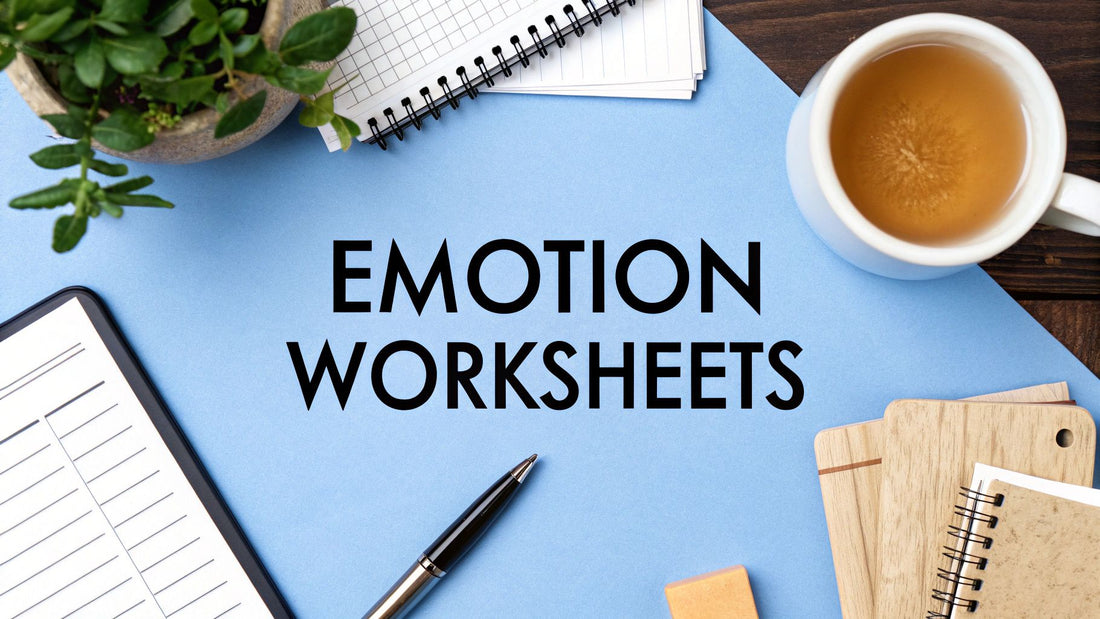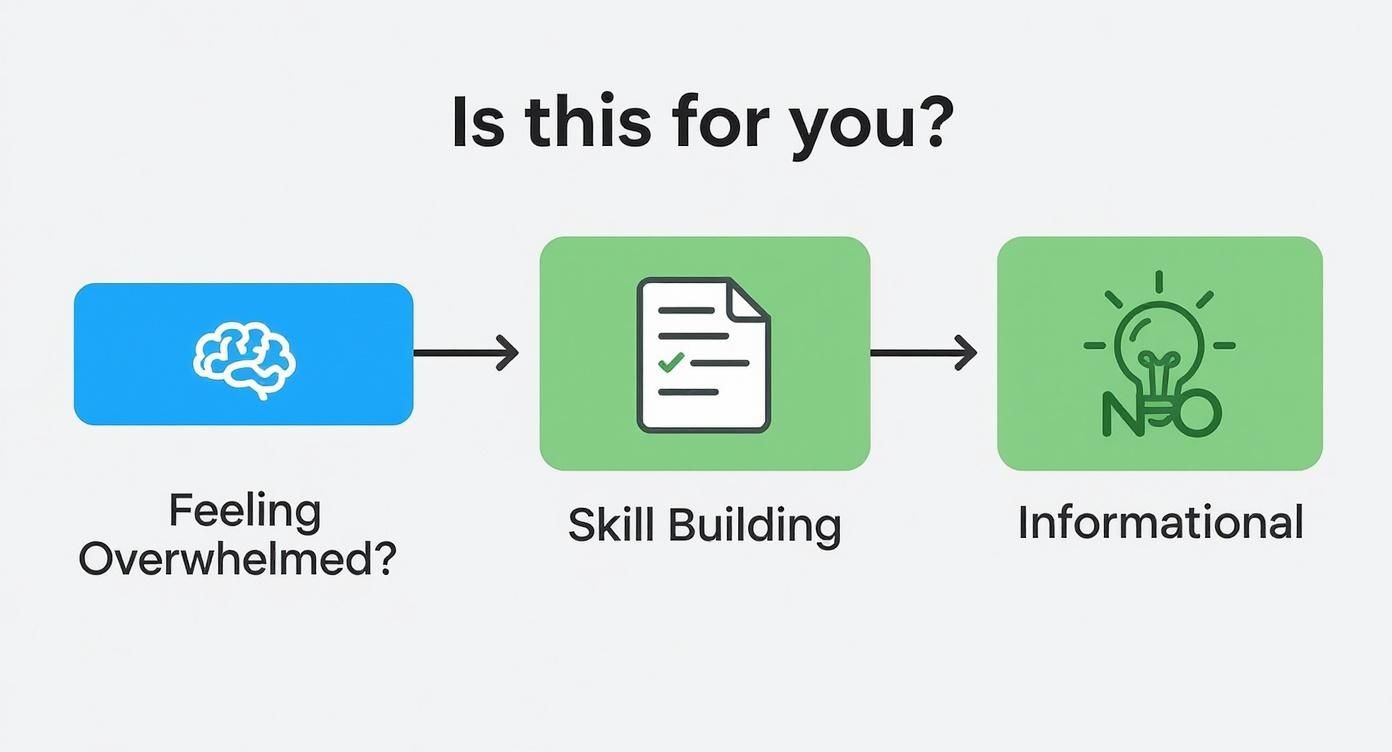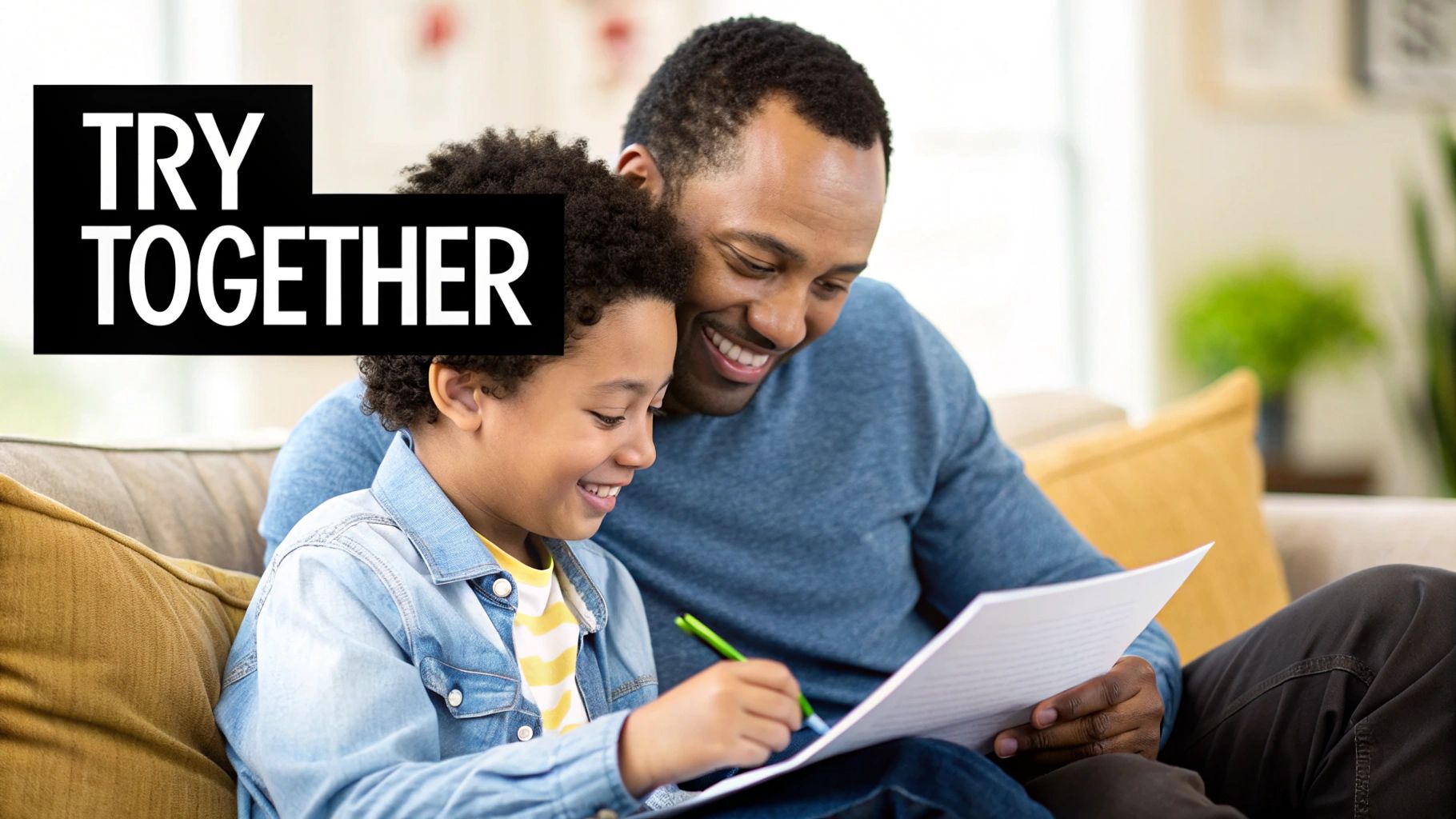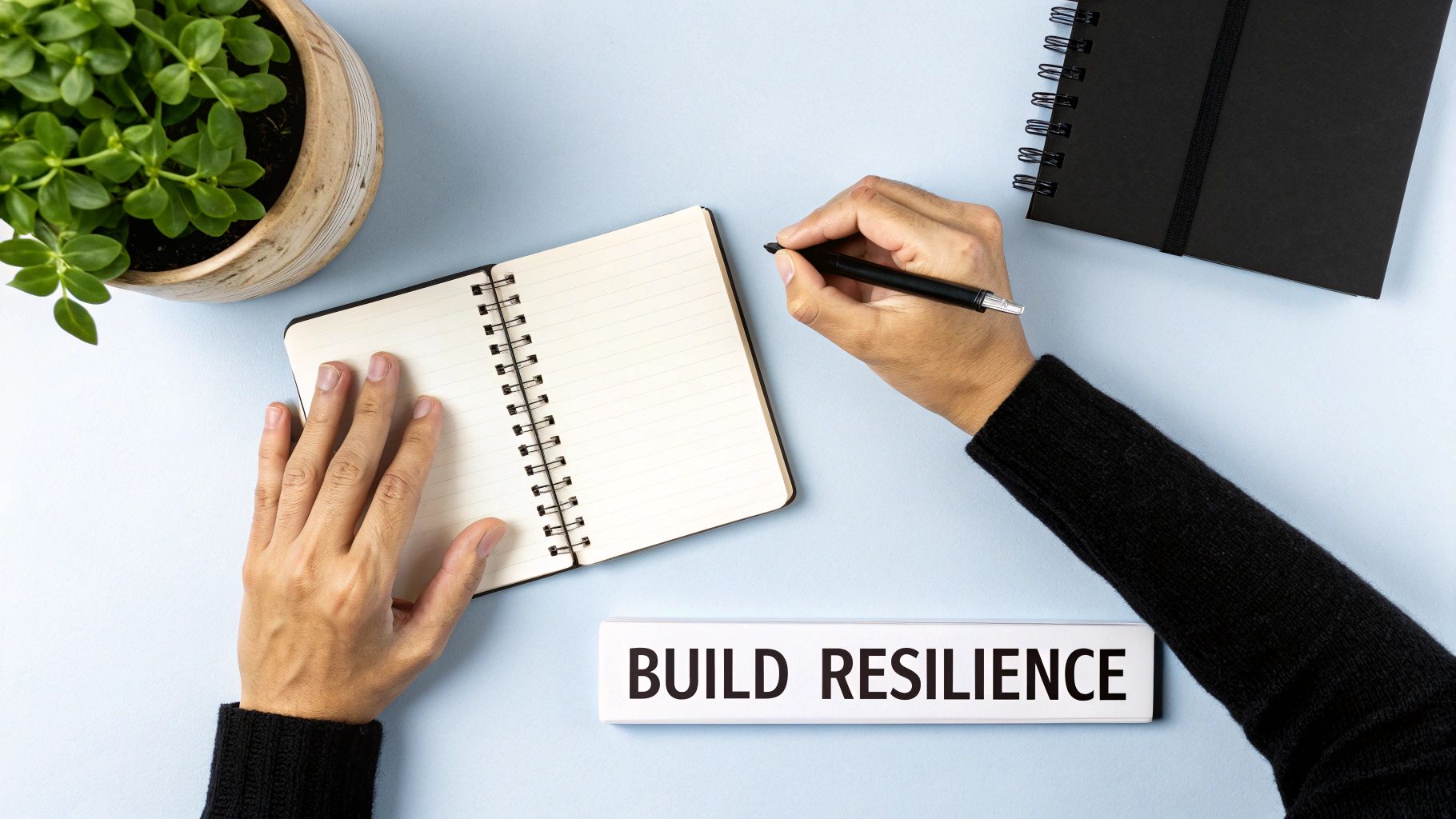
A Practical Guide to Emotion Regulation Worksheets
Share
Emotion regulation worksheets are practical tools designed to help children and adults identify, understand, and manage their feelings in a healthy way. They act as guided exercises, turning the abstract idea of managing emotions into a concrete, actionable skill.
Why Emotion Regulation Is a Skill Worth Teaching
Let’s be honest, "emotion regulation" can sound a bit clinical. But beyond the jargon, it's just the ability to manage our feelings so they don't manage us. It’s a core life skill, just as vital as learning to read or write, yet many of us reach adulthood without ever being formally taught how.
The conversation around mental health, especially for children and young people in the UK, is growing louder for a very good reason. Recent figures from NHS Digital show that one in five children now has a probable mental health condition. This really brings home the pressing need to equip them with the right tools to navigate an increasingly complex world.
The Modern Challenges to Emotional Wellbeing
Today’s youth face unique pressures that can make handling big feelings seem overwhelming. Constant academic expectations and the ever-present influence of social media create an environment where comparison and anxiety can easily take root. The Royal Society for Public Health has highlighted that social media use is linked to increased rates of anxiety, depression, and poor body image among young people.
This makes learning emotional skills more critical than ever. As a fundamental part of a child's overall wellbeing, emotion regulation is a cornerstone of good mental health. There are many different ways to improve child mental health, and building this skill is one of the most powerful.
Many of us adults find ourselves learning these skills right alongside our kids, which is why resources like emotion regulation worksheets have become so invaluable. The NHS Lothian's 'Finding the Calm' guide even describes emotional regulation as a fundamental life skill that many are still developing well into adulthood.
A Quick Note: While this guide provides information and practical tools, I am not a mental health professional. These worksheets are intended for educational and supportive purposes. If you have serious concerns about your own or a child’s mental health, it is essential to consult a GP or a qualified professional for guidance.
Building Resilience One Step at a Time
It's helpful to think of these worksheets not as a quick "fix," but as a starting point for building resilience. They open up conversations and provide a structured way to practise new coping strategies.
By using these tools, we can make it normal to talk about our feelings and, in doing so, build stronger, more emotionally aware individuals. For a deeper dive into the fundamentals, you might find our guide on what emotional regulation is and why it matters so much a helpful read.
Finding the Right Worksheet for Your Needs
With so many downloadable worksheets out there, picking the right one can feel a bit like wading through a sea of PDFs. The trick isn't just finding something that looks good; it's about matching the tool to the person, the situation, and the specific emotional skill you're trying to build. A simple ‘feelings tracker’, for example, might be spot-on for a younger child, but a teenager might get more out of a structured CBT-based exercise.
Think about a primary school child who gets easily frustrated in the classroom. A colourful ‘Zones of Regulation’ chart could be a game-changer. It gives them a simple visual language to figure out if they’re in the 'blue zone' (sad/tired), 'green zone' (calm/ready to learn), 'yellow zone' (worried/excited), or 'red zone' (angry/out of control). This kind of framework makes big, scary feelings feel a lot more manageable.
This decision tree can help you figure out if a worksheet is the right tool for the moment.

As you can see, if you're aiming for active skill-building to tackle an emotional challenge, a worksheet is an excellent place to start.
Selecting Age-Appropriate Tools
When it comes to younger children, you want to lean into worksheets that are highly visual and genuinely engaging. Think colouring pages that link colours to feelings, or simple matching games that help them put a name to emotions like 'happy', 'sad', and 'angry'. The main goal here is emotional identification—giving them the basic vocabulary they need to start expressing themselves.
For older kids and teenagers, you can start to bring in more complex ideas. A 'thought challenge record' is a brilliant tool for a teen grappling with anxiety. It walks them through identifying a negative thought, digging for evidence that supports or contradicts it, and then coming up with a more balanced, realistic perspective. These kinds of tools shift the focus towards cognitive reappraisal, a powerful skill for getting a handle on tricky thought patterns.
Remember, the best emotion regulation worksheets are the ones that feel collaborative, not like a test. The goal is to open up a conversation and provide a framework for exploring feelings together. This can also be a fantastic way to improve self-esteem. Our guide on worksheets for self-esteem explores this connection in more detail.
Worksheet Types for Different Age Groups
To make the selection process a bit clearer, it helps to see how different worksheet types line up with various age groups and the skills they target.
| Worksheet Type | Target Skill | Best For (Age Group) | Example Scenario |
|---|---|---|---|
| Emotion Colouring Pages | Emotional Identification | 3-7 years | A child colours a face yellow because they feel happy, linking a colour to an emotion. |
| Feelings Thermometer | Emotional Intensity | 5-10 years | After a disagreement, a child points to the "red" angry section to show how upset they are. |
| Zones of Regulation Chart | Self-Awareness | 5-12 years | A student identifies they are in the "yellow zone" (wiggly) before a test and uses a calming strategy. |
| Problem-Solving Steps | Executive Functioning | 8-14 years | A child uses the worksheet to brainstorm solutions for feeling left out during playtime. |
| Thought Challenge Record | Cognitive Reappraisal | 13+ years | A teenager challenges the thought "everyone thinks I'm awkward" by listing times they've had good conversations. |
This table is just a starting point, of course. You know your child or student best, so always feel free to adapt or choose what feels right for them. The key is finding a tool that resonates and feels helpful, not forced.
Key Factors for Your Checklist
Before you hit 'download' or 'print', it’s worth running through a quick mental checklist to make sure the worksheet is a good fit.
- Is it age-appropriate? Does the language and visual design feel right for their developmental stage?
- Is it visually appealing? A cluttered, boring, or overly "childish" design is unlikely to engage anyone.
- What specific skill does it teach? Is it for identifying emotions, solving problems, or challenging unhelpful thoughts?
- Is the tone positive and empowering? The worksheet should come across as a supportive guide, not a criticism.
It can also be useful to borrow ideas from experts who make study guides that actually work, as many of the same principles around clarity and engagement apply here, too. Ultimately, finding the perfect worksheet is all about being intentional and choosing a resource that feels accessible and genuinely helpful for your specific needs.
Introducing Worksheets Without the Awkwardness
Let's be honest, bringing up the idea of using an emotion regulation worksheet can feel a bit... clinical. How do you suggest it without making a child feel like they’re a problem that needs fixing, or like you’re just giving them more homework?
The secret is all in the approach. It’s about shifting the narrative from fixing a "problem" to building a new skill together. Think of it less like a therapist’s assignment and more like a shared activity that helps you connect. This simple change in perspective creates a safe, collaborative space where feelings can be explored without judgement.

Making It a Natural Conversation
The trick is to avoid dropping a worksheet on the table out of the blue, especially during a moment of high stress. Instead, try to weave these tools into your family's routine so they become a normal, helpful part of your emotional toolkit.
Here are a few conversation starters I’ve found work well:
- For a tough day: "Wow, that sounded like a really hard day at school. I've got this 'feelings thermometer' thing—shall we both fill one out to see where our energy is at?"
- For a disagreement: "I can see we're both feeling pretty frustrated right now. What if we used this problem-solving sheet to figure out a plan that works for both of us?"
- As a preventative tool: "You know, sometimes my feelings get really big and confusing. I found these cool worksheets that are like maps for your emotions. Fancy trying one with me sometime?"
This collaborative approach is powerful. It models healthy emotional expression and quietly reinforces that everyone—even adults—needs to work on these skills.
The most effective way to introduce these tools is by getting involved yourself. When a child sees you openly engaging with your own emotions, it immediately removes any stigma and transforms the activity into a moment of genuine connection.
Common Mistakes to Sidestep
To keep the experience positive and genuinely helpful, it's so important to avoid a few common pitfalls. Using these tools in the wrong way can backfire, creating resistance rather than openness.
Be careful to avoid:
- Using them as a punishment: Never, ever say, "You're having a tantrum, go to your room and fill this out!" This creates a direct link between expressing emotions and being punished, which can lead to shame.
- Forcing the activity: If your child isn't in the right headspace, don't push it. Respect their feelings and boundaries. You can always try again later when things are calmer.
- Interrupting an emotional storm: A worksheet is for processing feelings after the initial storm has passed, not during the peak of an outburst. First, focus on co-regulation and safety.
In the UK, there's a growing appreciation for a variety of emotional regulation activities for these very reasons. Simple, engaging tools like mood cards to build emotional awareness, calming breathing exercises, and even board games to practise frustration tolerance are all fantastic options.
These activities are not only fun but have been shown to reduce emotional outbursts and improve self-control. To find out more about how parents can empower their children to thrive emotionally and academically, have a look at some of the resources available. By framing worksheets as just one of many options in your toolkit, the whole process feels more flexible and a lot less rigid.
Using Worksheets in Schools and Therapy
When you're an educator or a mental health professional, you know that emotion regulation worksheets aren't just one-off activities. They're a powerful piece of a much larger puzzle, tangible tools that help reinforce the concepts you’re teaching in a lesson or a therapy session. They make those abstract emotional skills feel concrete and, most importantly, usable.
Think about how you could weave these into a school's Personal, Social, Health and Economic (PSHE) curriculum. Imagine you’re running a lesson on peer pressure. A 'Wise Mind' worksheet could be the perfect way for students to practise balancing logic with their emotional responses, helping them make thoughtful decisions instead of purely reactive ones. Suddenly, a theoretical chat becomes a hands-on, skill-building exercise.
Weaving Worksheets into Therapeutic Frameworks
In therapy, I've found worksheets are brilliant as practical take-home exercises. They act as a bridge between sessions, giving clients the confidence to apply what they’ve learned right in the middle of their daily lives.
For a client grappling with anxiety, a 'distress tolerance plan' worksheet can become a familiar, go-to resource during a moment of panic. It lays out the specific coping strategies you've already discussed and practised together, right there when they need them most.
Therapeutic models like Dialectical Behaviour Therapy (DBT) rely heavily on worksheets to teach these core skills. The whole idea of emotional regulation is deeply woven into mental health support in the UK, and DBT offers a really structured way to manage intense feelings. You can find some fantastic DBT-informed worksheets and tools from UK-based resources like Get Self Help. They have some excellent guides on dealing with distress that are worth a look.
It’s absolutely crucial to remember that these tools are designed to enhance, not replace, skilled teaching and therapeutic relationships. Their real power is unlocked when a professional uses them to support a bigger, individualised plan. A worksheet is the map, but the teacher or therapist is the guide helping navigate the journey.
Practical Tips for Professional Use
When you’re using worksheets in a professional capacity, how you present them is everything. You want them to feel like a supportive aid, never a test.
- Frame it as a tool: I always introduce a worksheet as a "tool to help us practise" or "a way for us to explore this idea together."
- Do it together: Especially when you’re introducing a new concept, work through the sheet with the student or client. It makes sure they grasp the ideas and feel supported.
- Make it your own: If a worksheet isn't a perfect fit, change it! Don't be afraid to cross out sections or add prompts that are more relevant to the person in front of you.
At the end of the day, these resources are at their best when they spark conversation and self-discovery. They provide the structure, but the real growth happens in the supportive dialogue around them, whether that’s in a bustling classroom or a quiet therapy room.
Building Resilience Beyond the Worksheet
An emotion regulation worksheet is a fantastic tool, but let's be honest, real resilience isn't built on a single piece of paper. It’s forged in the small, consistent moments of daily life.
Think of worksheets as your training plan, the map for the journey. But the strategies we're about to explore? Those are the daily exercises, the reps that strengthen emotional muscles over time. These are the simple, complementary techniques you can use anytime, anywhere, to ground a busy mind and build coping skills that actually last.

This isn’t just about feeling better as an individual; it's a skill with massive importance for everyone. Poor mental health costs UK businesses up to £56 billion a year through absence and lost productivity. When we teach emotional resilience from a young age, we’re laying the foundation for a healthier, more capable workforce for the future.
Simple Relaxation Tips for Tense Moments
When feelings get overwhelming, simple grounding techniques can bring immediate relief. The best part? They don't require any equipment and can be done discreetly, making them perfect for both children and adults in almost any situation.
- Box Breathing: A classic for a reason—it works. Breathe in for a count of four, hold for four, breathe out for four, and hold for another four. This simple rhythm is incredibly effective at calming the nervous system.
- The 5-4-3-2-1 Technique: This is brilliant for pulling your focus away from anxious thoughts and back into the present moment. Just name five things you can see, four you can touch, three you can hear, two you can smell, and one you can taste.
Just a quick note: I'm not a mental health professional. While these tips are genuinely helpful for managing everyday stress, it's so important to seek advice from your GP or a qualified therapist if you have serious worries about your or your child's mental health.
Continuing the Conversation Off the Page
Normalising conversations about mental health is probably the most powerful thing we can do. The more we talk about feelings openly, the less stigma they hold, and that creates a truly supportive environment. This is where other resources can play a wonderful role.
Books are a fantastic way to explore complex emotions in a way that feels safe and accessible. For younger children, titles like The Colour Monster by Anna Llenas are brilliant for introducing emotional vocabulary. For older teens and adults, books like Matt Haig’s Reasons to Stay Alive can open up vital conversations that might otherwise feel too difficult to start.
If you'd like to explore this topic further, our guide on how to build emotional resilience offers even more strategies and insights.
Even something as simple as mental health apparel—a t-shirt or a hoodie with a positive message—can act as a conversation starter. It's a quiet, visual way of saying, "It's okay not to be okay," helping to break down barriers and foster a culture of understanding that extends far beyond any single worksheet.
Common Questions About Emotion Regulation Worksheets
It’s completely normal to have questions when you first start using emotion regulation worksheets. They’re brilliant tools, but every child is different, and so is every situation. Let's walk through some of the most common queries we hear from parents, teachers, and therapists.
How Often Should We Use Worksheets?
Honestly, there’s no magic number here. The key is to find a rhythm that works for your family.
For some, a weekly check-in becomes a predictable, comforting part of their routine. For others, it’s much more effective to pull them out on an as-needed basis—maybe after a particularly tough day at school or when you notice big feelings bubbling up.
The goal is consistency over intensity. It’s far better to have a meaningful five-minute chat over a worksheet once a week than to push for daily use if it feels like a chore. Just listen to your child; if they're showing signs of fatigue with the activity, it’s perfectly fine to take a break.
What if My Child Refuses to Engage?
First off, take a deep breath and don't force it. The last thing you want is a power struggle that creates a negative feeling around talking about emotions. That defeats the whole purpose.
Instead, get curious. Try to figure out what's going on behind the refusal. Is the worksheet a bit too complicated? Is the timing off? Are they just not in the right headspace to sit down and focus?
Sometimes, the best approach is to simply model the behaviour yourself. You could try saying something like, "I'm feeling a bit stressed today, so I'm going to fill out one of these." This takes the pressure off them entirely and can spark their natural curiosity. Above all, remember that patience is your most valuable tool.
Important Reminder: I am not a mental health professional. While these worksheets and tips are designed to be supportive, they are not a substitute for professional advice. If you have serious concerns about your or your child's mental health, please speak with your GP or a qualified therapist.
Where Can I Find More Resources?
Building emotional skills is a journey, not a destination, and it goes far beyond a single worksheet. To keep the conversation going and build a supportive atmosphere at home, you can weave in other resources.
Here are a few ideas to get you started:
- Mental Health Books: Reading stories that explore different emotions can be a wonderfully gentle way to introduce complex topics and open up discussions.
- Relaxation Techniques: Simple practices like deep belly breathing or going for a quiet walk together can be powerful complements to the activities in the worksheets.
- Mental Health Apparel: Sometimes, something as simple as wearing clothing with positive, affirming messages can help normalise conversations about mental health in everyday life.
Using these kinds of resources helps create a family culture where talking about feelings is a natural, accepted, and even welcome part of the day.
At Little Fish Books, we're passionate about nurturing emotional literacy in young people. From free downloadable colouring sheets to engaging books and supportive merchandise, our resources are designed to help families and educators build resilience together. Explore our full collection at thatsokay.co.uk to find the perfect tools for your journey.
